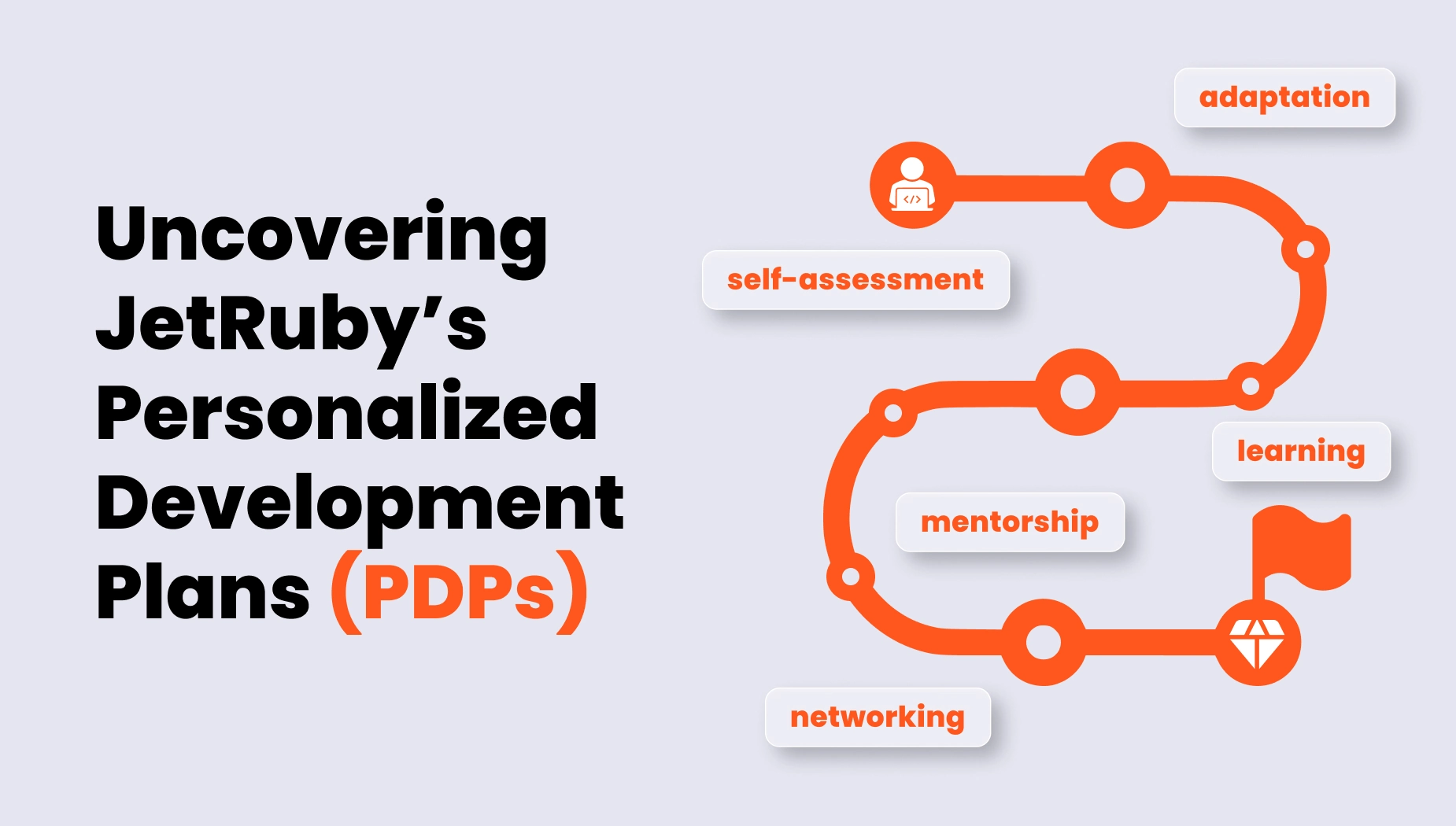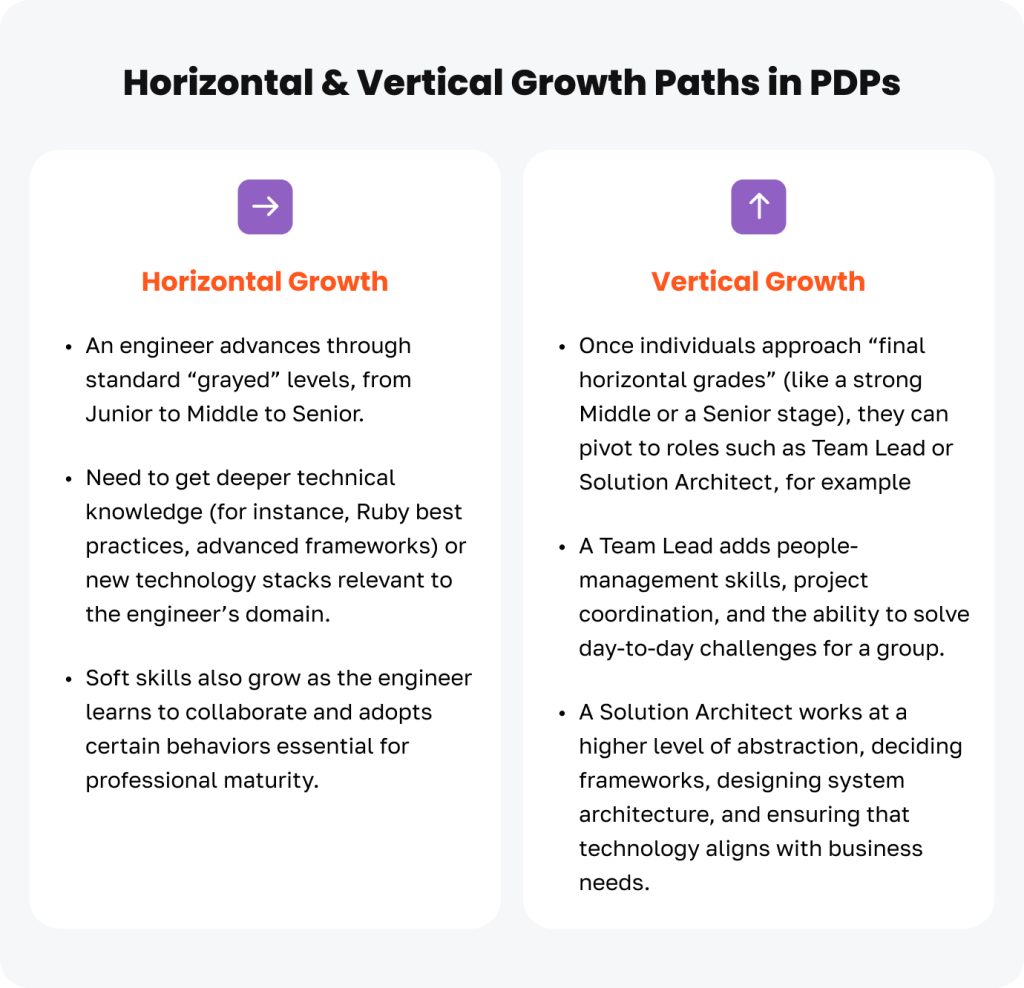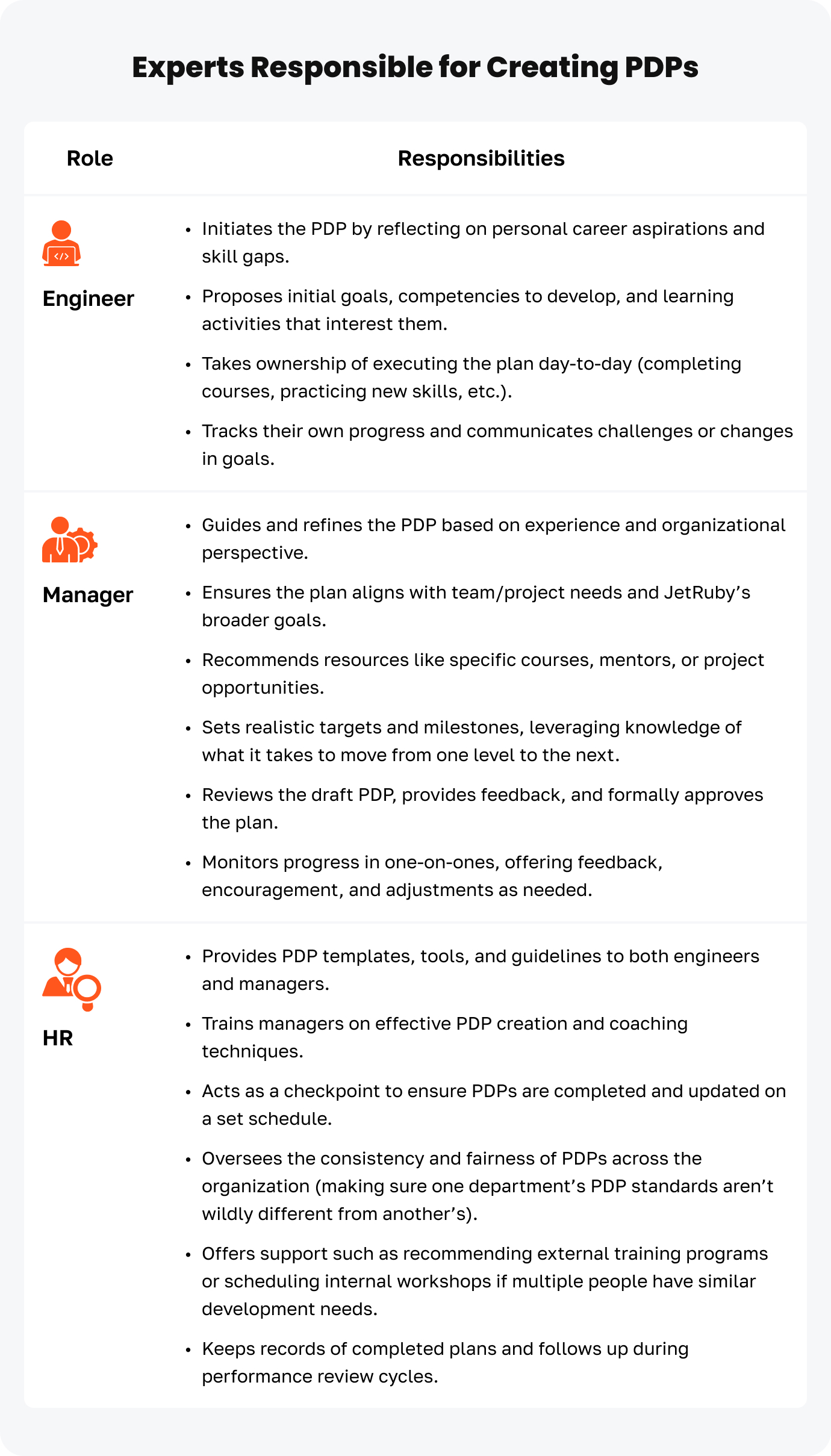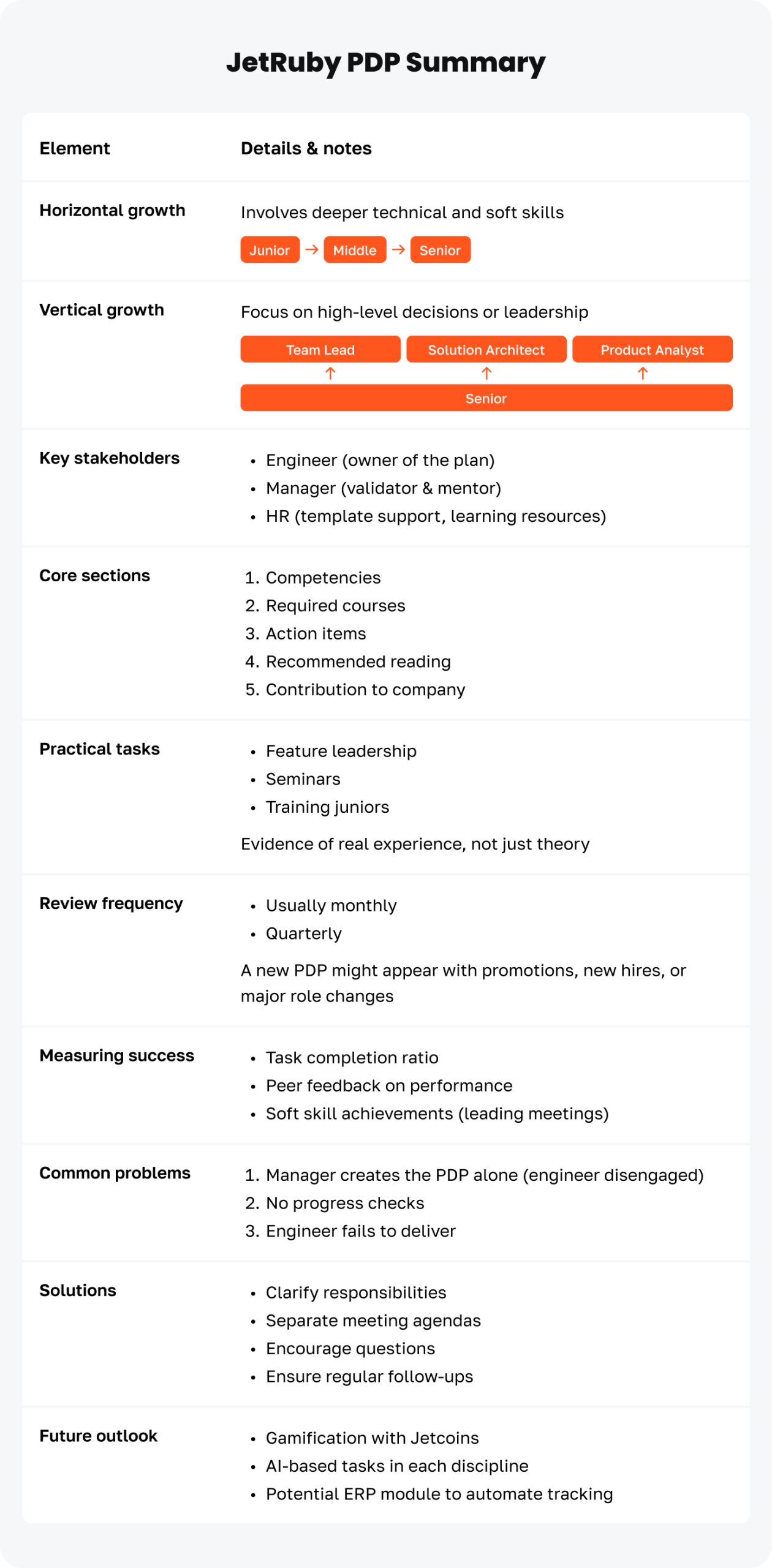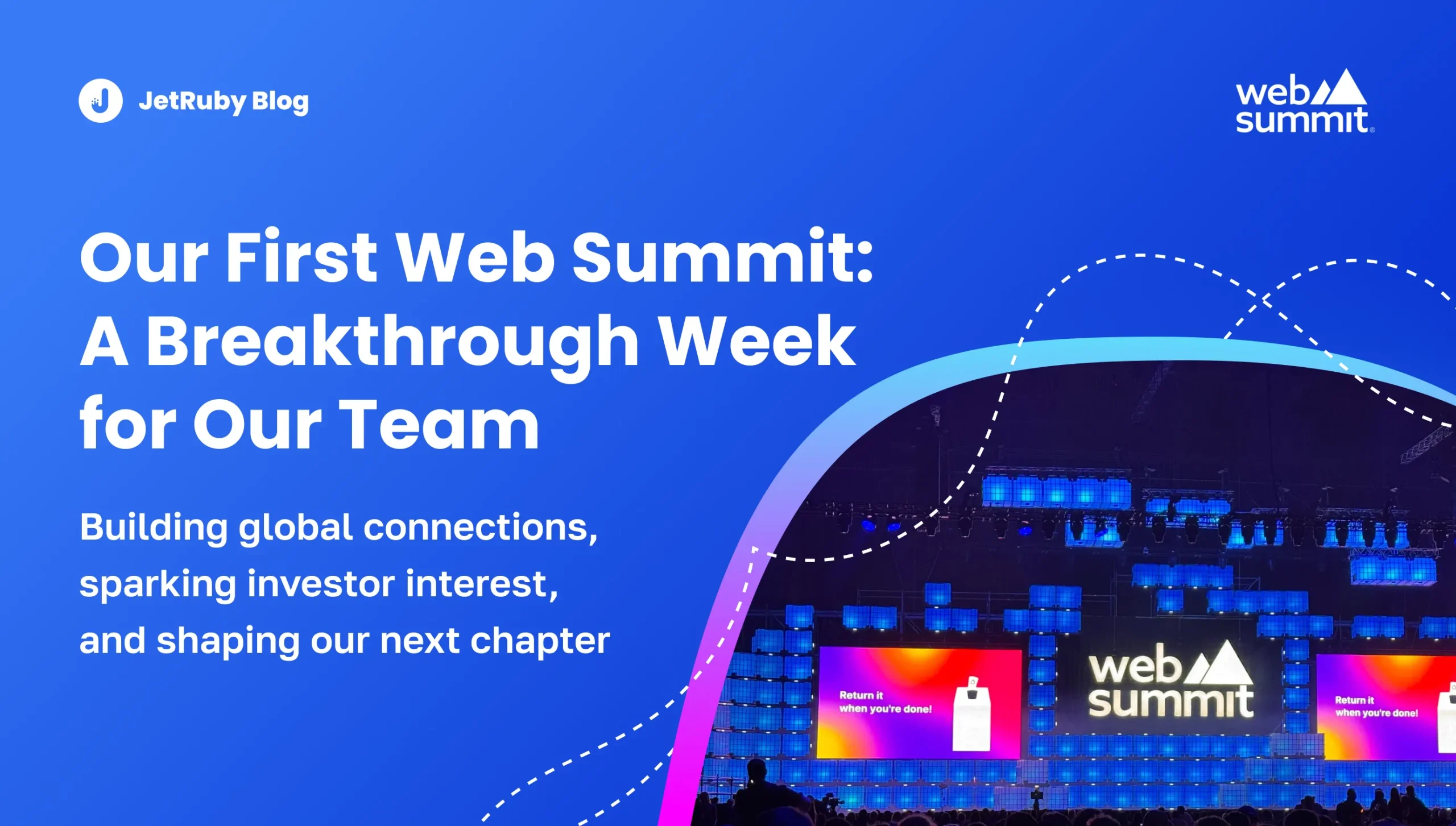Table of Contents
What’s the cost of stagnation? In the tech industry, it could be your best engineers walking out the door.
More than 70% of high-retention-risk employees say they plan to leave their company to advance their careers elsewhere. On the flip side, 94% would stay longer if their employer invested in their development.
Those numbers highlight a hard truth: fostering continuous growth for engineers is a strategic imperative. Companies that prioritize professional development see tangible benefits, including up to a 58% increase in employee retention.
When engineers see a clear path to grow, whether by mastering new technologies or taking on bigger responsibilities, they feel valued and motivated.
This effect is mutual: organizations benefit from upskilled talent and often fill senior positions internally, which is more efficient and culturally seamless than hiring externally.
We at JetRuby recognize these benefits so we have built a culture where engineers are continually growing.
One key to this success is a Personalized Development Plan (PDP). It’s a structured roadmap that guides each engineer’s career progression.
In this in-depth guide, we’ll share how we create and maintain PDPs, highlight the roles different team members play, and explain how progress is tracked and measured.
Let’s dive in!
Personalized development plans (PDP) explained: Why JetRuby invests in PDPs
So, what is a PDP and why does it matter? And how do we see it?
A Personal Development Plan (PDP) at JetRuby is a formal document and process that maps out an engineer’s growth trajectory.
In simple terms, it’s a tool for improving an employee’s skills and advancing their career within the company.
A PDP encourages continuous learning and adaptation, which is crucial when “you never stop learning” in software development.
Moreover, engineers (particularly younger professionals) expect growth opportunities. Surveys show that lack of development is holding back 74% of employees from reaching their potential. And 70% feel they lack the skills to do their jobs efficiently.
In short, engineers want to improve, and companies need them to improve. A personalized PDP provides a focused way to make that happen, benefitting both the individual and the organization.
In a PDP, an engineer (with input from their manager and others) outlines their career goals, identifies the skills and competencies they need to reach those goals, and lays out a detailed action plan (training, projects, mentorship, etc.) to build those skills within a given timeframe.
A PDP takes someone’s career aspirations, say becoming a senior backend developer or transitioning into a DevOps role, and breaks them down into achievable milestones.
A comprehensive PDP also considers soft skills, leadership development, and personal interests in addition to technical abilities.
How does JetRuby’s PDP approach stand out?
While many companies use some PDP forms, JetRuby’s approach carries a unique flavor.
Traditional PDPs can sometimes be generic HR checklists. For example, “complete X training modules” or “attend a workshop” without much customization.
At JetRuby, the PDP is personalized and deeply integrated with our day-to-day work. We design each plan around the engineer’s individual interests and strengths and the company’s technology roadmap.
For instance, if one of our developers is keen on cloud engineering and we foresee more AWS projects on the horizon, their PDP will likely include an AWS certification course and a hands-on cloud deployment project.
This alignment ensures the engineer grows in a direction that’s fulfilling for them and valuable for JetRuby.
We also encourage creativity. An engineer can propose a custom project or research task as part of their growth, which we readily incorporate into their growth journey.
Aside from this, JetRuby’s PDP process is ongoing and iterative.
It’s not limited to an annual review cycle. Engineers and their leads revisit and update development plans regularly (as we’ll detail later), which keeps the plan relevant as projects change or as the engineer achieves milestones.
Another distinctive aspect of JetRuby’s PDP philosophy is addressing both horizontal and vertical growth paths.
As you can see it in this image, growth isn’t always about climbing a straight ladder upward. It can also be about broadening one’s skill set or shifting into a different track.
Imagine an engineer who joined JetRuby as a Junior Ruby developer. After mastering basic syntax, debugging, and testing, they become a middle developer.
They pick up deeper architectural concepts and show stable performance. At middle-strong, their PDP includes advanced items such as performance tuning, concurrency, or more complex system design. This sets them on track for the Senior level.
Once they feel comfortable operating at Senior scope, they have a few potential vertical moves.
As mentioned in the table above, one can lead toward team leadership. They learn about people management, agile methodologies, and project planning.
The other can lead toward solution architecture. They shift from daily coding tasks to planning entire systems or reviewing technical proposals.
Both appear on the PDP with specific assignments or goals.
The people behind the plan: Who shapes a PDP?
Crafting a PDP at JetRuby is a team effort. There are three key players in the process: the engineer, their manager, and the HR team.
The image below outlines who does what when it comes to creating and reviewing a development plan.
As the table suggests, the engineer is at the center of their PDP. Their motivation provides the initial spark.
We encourage engineers to take the initiative — after all, it’s their career. They come up with ideas about where they want to go and what they want to learn.
The manager plays the role of a coach and sounding board. Rather than dictating goals, JetRuby managers collaborate with engineers to shape the plan.
They’ll suggest what skills might be important for the engineer’s next step or how to tie an individual’s goals into upcoming projects so the learning can happen on the job.
The HR team provides the process and tools to make it all possible. HR’s involvement ensures that everyone is actually taking the time to do PDPs and that the plans align with JetRuby’s career progression framework.
For example, HR might remind a manager when it’s time for an engineer’s semi-annual PDP review or supply a list of recommended courses for a skill that many engineers aim to develop. They keep an eye on the bigger picture of development across the company.
Anatomy of a JetRuby PDP: structure and format
Now that we know the parties who craft a PDP, what does the plan actually look like?
Each development plan at JetRuby follows a clear, structured format to ensure consistency and thoroughness.
But not all PDPs look the same.
They are personalized not only to the individual but also tailored to the engineer’s specialization and level of experience.
A junior engineer’s development needs differ from a senior engineer’s. A backend developer’s needs will differ from those of a QA engineer.
And JetRuby’s PDP format accommodates these differences.
Our PDP template is typically organized into a few key sections, each serving a distinct purpose.
Competencies and goals
We start by clearly stating the competencies or skill areas the engineer is aiming to develop. These are essentially the goals of the PDP.
A competency could be technical (e.g. “Deepen expertise in React and state management” or “Learn automated testing practices”) or non-technical (e.g. “Improve team leadership skills”).
Defining specific focus areas sets the direction for all other parts of the plan.
Along with each competency, we often note the current proficiency level and the target level to reach (for example, from intermediate to advanced). This gives a measurable context to the goal.
Another unique element of our PDP approach is the long-term development focus we especially apply for what we call middle-strong engineers (solid mid-level developers).
For these folks, we think beyond just the next immediate milestone. We believe that middle-strong employees must explore a vertical track early (management, architecture, or product analysis, for example).
This encourages them to see the bigger picture beyond daily tasks and prepare for future roles. And their PDP might be deliberately planned with a longer horizon in mind, looking at growth over the next year or more.
For example, a mid-level engineer’s plan could have staged progression.
First, master a set of technical skills (say, advanced backend development techniques). Next, apply them by leading a medium-sized project. And later, develop leadership capabilities by mentoring a junior colleague on that project.
The idea is to continuously build momentum so that by the time they’re ready for a senior role (or another vertical move), they’ve been steadily preparing for it.
Required courses and training
For each competency, the plan lists formal learning resources that an expert must complete. This could include online courses, certification programs, workshops, or even structured reading assignments.
The key is that these are mandatory learning activities directly tied to the competency.
For instance, if the competency is mastering cloud deployment, a required item might be “Complete the AWS Certified Developer training module”.
JetRuby’s template often encourages naming a specific course or resource and an expected completion date to create accountability.
Timeline and milestones
A good PDP assigns target dates or timeframes to the action items and goals. This creates accountability and a sense of progression.
For example, an engineer’s plan might set a milestone to “Deploy a microservice independently by end of Q3” or “Lead one code review session by next month.”
Milestones break the journey into manageable checkpoints. They answer the question: “What progress should be made by the next check-in?”
At JetRuby, typical PDP timelines might run on quarterly cycles for short-term goals, with longer-term goals revisited semi-annually or annually.
Success criteria and KPIs
To know if development efforts are paying off, the PDP should define how to measure success.
This could be quantitative metrics (e.g., “Achieve 80% or higher on code quality metrics by year-end”, or “Get certified in XYZ”) and qualitative indicators (“Manager observes clear improvement in sprint planning contributions”, “Peers report better communication in team surveys”).
For softer goals, feedback from team members or mentors can serve as a metric.
The key is that both the engineer and their lead have a clear idea of what “improved” or “achieved” looks like for each objective.
Hands-on activities
Knowledge isn’t very useful until it’s applied.
This section outlines practical, on-the-job activities or projects for the engineer to put new skills into practice.
We prioritize these hands-on tasks heavily at JetRuby.
Our philosophy is that practical tasks outweigh theoretical knowledge.
It’s not that theory isn’t important. You need to learn concepts first, but we consider a competency truly gained when the engineer has applied it in a real scenario, and even taught it or shared it.
Examples might be “Implement a new feature using technology X”, “Lead the next code review session to improve code quality”, or “Draft and execute a load testing plan for our application module”.
These activities are where real skill growth happens. The engineer moves from theory to practice.
Often, a hands-on task is directly aligned with ongoing work (so the learning integrates with real project needs). The PDP includes these tasks as a key measure of competency.
These competencies often get tied to certain mastery levels:
- Doesn’t know about it.
- Knows the basics.
- Applied it at least once.
- Mastered and can teach others.
As the engineer moves forward, different competencies shift from “basic knowledge” to “proficient.”
Optional resources
In addition to the required courses, we provide a list of optional resources for each competency. These could be books, articles, tutorials, or videos that are not mandatory but can deepen understanding.
For example, alongside a required React course, an optional resource might be “Official Redux documentation and advanced patterns blog series”. These give motivated engineers the opportunity to explore beyond the basics at their own pace.
We call them “optional” to differentiate from the must-do items, but many engineers at JetRuby eagerly consume these resources as well, since they’re often curated by senior staff who know which materials are high-value.
Advance Your Product With CTO as a Service! Build, attract investors, report progress, and secure the right team to achieve your goals.
Crafting a growth path: How and when JetRuby engineers build their PDPs
Now that we know the “what” of a PDP, let’s look at the “how.”
The process of creating a PDP at JetRuby is systematic yet flexible. It ensures every plan is well-thought-out and agreed upon, but it doesn’t impose unnecessary bureaucracy or one-size-fits-all timing.
Here’s a step-by-step look at how to create a PDP.
Initiation
An employee can initiate a development plan at various points. Often, it kicks off during a regular review cycle (for example, as part of a semi-annual performance review).
In other cases, a trigger event prompts a new PDP.
- Promotion: An engineer ready for a next-level role.
- Position change: A shift from QA to analysis or from analysis to management.
- Performance review: A manager or HR sees that an employee needs a performance evaluation.
- New hire: After the initial months, a new hire will need their own PDP.
The initiation step typically gets the engineer and their manager agreeing that it’s time to create or update a PDP.
This can be a Google Sheet or an Excel template.
For junior hires, JetRuby has “pre-made” pathways that list typical skill sets for the next grade.
Self-assessment & goal proposal
Next, the engineer takes some time for introspection and research. They assess their current skills against the expectations of their desired next role or proficiency level.
Based on this, the engineer drafts an outline of goals or competencies they want to develop (as described in the previous section). They might also list some learning activities they’re interested in (e.g. specific courses or projects).
At JetRuby we provide a self-assessment worksheet and competency matrix to help engineers think through areas of improvement and interest.
Manager feedback & co-design
The engineer and manager then meet to discuss the draft goals. The manager brings their perspective on what skills the engineer should prioritize, considering both the engineer’s aspirations and the team’s needs.
They might suggest additional competencies (for instance, “You mentioned focusing on backend performance; I think adding database scaling techniques would be beneficial given our upcoming project”).
They also ensure the goals are ambitious yet attainable.
Together, they refine the list of competencies and decide on the most important ones to include in the PDP.
This step exemplifies JetRuby’s flexible yet structured ethos: there’s a clear meeting and review, but it’s a free-form discussion tailored to the individual, not a rigid form to fill out.
Drafting the PDP document
With the agreed-upon goals in mind, the engineer (often with the manager’s guidance) fills out the PDP template. They specify the competencies, required courses, hands-on activities, and optional resources as finalized in the previous discussion.
They will also set tentative timelines or target completion dates for each item (for example, “Complete Docker online course by end of Q3” or “Lead testing initiative in next sprint”).
The outcome of this step is a written PDP document that both the engineer and manager can review.
Review & approval
The manager reviews the completed PDP document to ensure it accurately captures what was discussed and that it aligns with both personal and company objectives.
If something looks off or needs detail, they work with the engineer to adjust it. Once both are satisfied, the manager officially approves the PDP.
After approval, the PDP is now active.
From here, the engineer begins working on the plan, and the manager will incorporate PDP items into their regular check-ins.
Note: Some managers mix four types of conversation: performance scolding, mental well-being check, project updates, and development planning. That can confuse the employee.
Instead, separate them. For instance, if someone messed up a deployment, handle that next day in a short call. Save the PDP talk for a dedicated session.
Keeping PDPs on track: monitoring progress and making adjustments
Creating a plan is only half the process. Monitoring ensures that it does not gather dust. A PDP that no one revisits helps nobody.
Our team believes a PDP is “alive,” meaning it changes if the project environment evolves or the engineer decides to explore a new skill.
We at JetRuby suggest a stable “progress slice” at least once per quarter. However, many of our employees address it monthly. These quick updates let them pivot if certain tasks become irrelevant or if new opportunities arise.
JetRuby measures PDP outcomes by the ratio of completed tasks plus the performance feedback from managers and team members.
Each PDP lists tasks or courses. The manager can see how many items are done, how many remain, and whether the engineer has partial progress.
Besides, an engineer’s growth is not limited to technical items. Soft skill improvements, leadership potential, or creative problem-solving also factor in.
According to a hard skill review matrix, there are five employee performance levels:
- Unacceptable
- Need Improvement
- Meet Expectations
- Exceed Expectations
- Outstanding
We use these performance levels when evaluating the success and impact of PDPs. Now, let’s look at the following metrics that we measure to monitor the PDP progress.
| Metrics | Description |
|---|---|
| Goal completion rate | We track how many of the PDP items (courses, projects, activities) each engineer completes within the planned timeframe. A high completion rate suggests the engineer stayed on track and the scope was reasonable. It’s not about chasing 100% for its own sake, but this gives us a pulse on engagement. If we saw consistently low completion, that’s a red flag that something’s off (maybe the engineer lacked time or the plan was too ambitious). |
| Skill improvement & performance gains | More important than raw completion is how the engineer’s capabilities have grown. Managers do a before-and-after assessment in the areas targeted by the PDP. For instance, if the plan focused on React proficiency, is the engineer now handling front-end tickets more independently and with better quality? We look for concrete evidence in work performance — fewer bugs, faster delivery, more innovative solutions. |
| Career progression (promotions or role changes) | One clear marker of PDP impact is whether it enables career moves. We track how many engineers get promoted or transition to desired roles following the completion of their development milestones. At JetRuby, we’ve seen a strong correlation — engineers who diligently execute their PDPs often earn more responsibilities and new titles. |
| Employee feedback and engagement | We regularly solicit feedback from engineers about the PDP process. This happens in one-on-one discussions and via anonymous surveys. We want to know if they found the plan valuable, if the resources were helpful, and how supported they felt. A high percentage of positive feedback (e.g., engineers saying “My PDP helped me focus my growth” or “I feel more engaged with the company because of this process”) is a sign of success. |
While we track these metrics, JetRuby is careful not to boil development down to just numbers.
We don’t consider a PDP “successful” only when every single box is checked or when an employee completes an assessment with a high score.
Quality and consistency of growth matter more than quantity.
For example, if an engineer completed all their courses but still struggles to apply the skills in real projects, that PDP might need revisiting.
On the other hand, an engineer might complete 80% of the plan but already exhibit significant improvement in their role — we’d still call that a win.
JetRuby’s way of measuring PDP success aligns with our company culture and values.
The big picture: Why do PDPs matter for JetRuby
A well-structured PDP program creates a win-win scenario for both engineers and the company. At JetRuby, we’ve seen numerous advantages unfold thanks to our focus on developing people from within.
We have a culture that celebrates continuous learning, taking initiative, and helping each other improve. The PDP process reinforces that culture by making growth a shared goal between the company and the individual.
One of our core beliefs is “invest in people, and they will invest in you.”
Here are some of the key benefits.
Faster career growth & satisfaction (engineer perspective)
Engineers with PDPs have a clear roadmap to follow, which often accelerates their development. Instead of drifting or learning in ad-hoc ways, they focus on targeted skills that lead to real advancement.
This means a motivated junior developer can reach mid-level competency more quickly, and a mid-level can groom themselves for senior roles systematically.
The effect on morale is tangible — when engineers see themselves hitting milestones and growing, job satisfaction soars. They feel a sense of purpose and direction in their career.
Higher retention & loyalty (company perspective)
From JetRuby’s side, investing in our engineers’ growth pays back in loyalty.
People stick around when they see a future for themselves. Our retention rates among engineers who are actively following a PDP are significantly higher than industry averages.
It’s common for talent in the tech industry to hop from company to company looking for the next big opportunity, but at JetRuby, we aim to provide those opportunities in-house.
JetRuby has enjoyed strong retention among our engineering team, and internal analysis shows that those who actively engage in their PDPs tend to stick around and advance within the company.
It makes sense: if you’re growing your career here, you have less reason to look elsewhere.
Robust internal talent pipeline
JetRuby’s emphasis on internal development means we rarely need to hire mid-level engineers from outside.
We can promote from within for most openings thanks to our internal academy and training courses. This is a huge strategic advantage.
It can take months to recruit and onboard an external senior developer, and there’s always a risk they won’t mesh with the company culture or processes.
In contrast, an internal promotee hits the ground running: they know our codebase, our tools, our clients, and our values.
Over the years, we’ve built a bench of talent ready to step up when leadership roles open.
Many employees joined JetRuby more than 10 years ago. They started as interns, learned the standards, advanced through Middle and Senior levels, and took on leadership roles.
Their long tenure shows how the PDP fosters loyalty. They also highlight the thorough knowledge of processes that helps them guide new cohorts.
Cost savings & efficiency
Developing talent internally is also cost-efficient.
Hiring experienced engineers from the market is expensive: recruiters’ fees, higher salary demands, and longer ramp-up times.
Some studies even show external hires get paid more but perform worse for their first couple of years compared to internally grown staff.
By growing our own, JetRuby reduces those extra costs.
Instead, we channel a fraction of that expense into training courses, conference passes, and mentorship hours for our team.
The result is we get the expertise we need without breaking the bank, and we cultivate a reputation as a company that prefers to “grow our own.”
This approach is sustainable and scalable. As JetRuby takes on new technologies or projects, we upskill our existing people to meet the challenges.
Employee value proposition & employer brand
From a broader perspective, our commitment to developing engineers is a key part of JetRuby’s identity.
It’s a selling point when recruiting.
We often hear candidates say they were drawn to JetRuby because they heard about our learning culture or saw that we promote from within.
In a competitive talent market, this is a differentiator.
Internally, it boosts morale and community. Colleagues celebrate each other’s progress, whether it’s someone finishing a certification or moving into a new role.
It creates a positive feedback loop: success stories fuel others to pursue their own growth. That cultural strength translates into better teamwork and commitment, which ultimately benefits every project we undertake.
Transform Your Business With CTO & Talent Management as a Service! Streamline IT, boost profits, and drive innovation.
Staying ahead: adapting PDPs for the future
The tech industry never stands still, and neither will JetRuby’s approach to engineer development.
We continuously adapt our PDP program to prepare our team for the skills and challenges of tomorrow.
Here’s a glimpse of how we see our PDP methodology evolving in the near future.
Embracing emerging technologies
Just as we tailor PDPs to individual goals, we also align them with industry trends.
One big focus area is AI integration.
The idea is that a junior plus AI might match (or even surpass) a standard engineer’s output. Meanwhile, a senior plus AI could excel at tasks that previously took many hours or even days.
Software engineers increasingly need to understand artificial intelligence and machine learning, whether it’s incorporating AI features into applications or using AI-driven tools in development.
JetRuby plans to weave AI-related learning into our PDPs.
- Engineers might have PDP tasks like “Experiment with an AI-based code generator,” or “Use an advanced prompt to produce test coverage.”
- Over time, this might become mandatory for certain roles, as AI becomes mainstream.
Gamification
Another future-forward initiative is the gamification of professional development.
We believe we can make learning more engaging by introducing game-like elements and rewards.
To that end, JetRuby has started experimenting with an internal currency called JetCoins.
Engineers earn JetCoins for hitting certain development milestones. For instance, completing a course, achieving a certification, giving an internal tech talk, or mentoring a junior engineer.
Employees can later redeem these JetCoins for various perks like branded notebooks, cups, equipment, or partial travel sponsorship.
- Early results are promising: we’ve noticed a spike in voluntary course completions and knowledge-sharing sessions.
- This fosters a culture of engaged professionals who look beyond their immediate tasks.
- A PDP might include optional tasks that reward Jetcoins. For example, “Lead 2 external meetups for open-source frameworks.”
ERP integration for PDP
Currently, managers or employees store PDPs in a spreadsheet or Google Sheet. A future plan includes a specialized module inside our internal ERP system.
This would allow:
- Easy traceability of tasks.
- Direct alignment between the PDP and company-level goals.
- Automated reminders about tasks or deadlines.
- The possibility for managers to see a consolidated view of all plans in the team.
Closing thoughts
While we incorporate new tools, technologies, and incentives, the heart of JetRuby’s PDP approach will remain the same. Our mission is to develop top-notch engineers and leaders from within our ranks.
JetRuby’s Personalized Development Plan (PDP) stands out for its balanced approach:
- It addresses both horizontal growth (Junior → Middle → Senior) and vertical expansions (Team Lead, Architect, Product).
- It places responsibility on the engineer to define personal goals while giving managers and HR roles to support and guide.
- It integrates real tasks, not just theory.
- It remains flexible, adjusting to new project needs or personal interests.
- It directly ties into the company’s matrix of competencies and underlying values.
The table below highlights the summary of our PDP essentials.
Everyone reaps the rewards through better collaboration, advanced skill sets, and improved outcomes on projects. The central theme is simple: each person owns their journey, but JetRuby provides the pathways and support that make it a truly collaborative experience.
If you have any questions left, please contact us any time you see fit!
